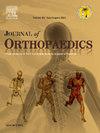上囊重建与背阔肌转移治疗后上不可修复的肩袖撕裂,无关节炎改变:中期交叉研究
IF 1.5
Q3 ORTHOPEDICS
引用次数: 0
摘要
背景背阔肌转移(LDT)是一种众所周知的肌腱转移技术,具有长期的临床随访结果,而上囊重建术(SCR)最近成为后上不可恢复性肩袖撕裂(PSIRCTs)的治疗选择。然而,只有少数小规模的短期比较研究评估了SCR和LDT。我们评估了无关节炎改变的psirct中SCR和LDT的临床和放射学结果。方法本回顾性临床比较研究评估了接受SCR或LDT治疗的psirct患者,并进行了中期(至少5年)随访。SCR组28例,LDT组31例。使用视觉模拟量表(VAS)评分、患者报告的临床结果评分和活动范围(aROM)来评估临床结果。影像学结果包括肩关节骨性关节炎进展和移植物完整性分别采用Hamada分级和Sugaya分级进行评估。结果两组患者VAS评分及aROM均有显著改善。LDT组报告了所有患者报告的结果评分的显著改善。然而,SCR组除了美国肩肘外科医生的评分外,患者报告的结果评分没有显著改善。放射学结果显示,两组AHD均显著降低,Hamada评分均显著升高。此外,LDT组关节炎变化的进展明显更大,而SCR组的移植物复发率明显更高。结论:尽管SCR和LDT均能改善临床结果,但就患者报告的结果评分而言,LDT优于SCR。然而,骨关节炎的进展在LDT中更常见,而移植物复发在SCR中更常见。因此,在没有关节炎改变的psirct中,SCR或LDT可以考虑作为手术治疗,但必须考虑临床结果以及并发症(骨关节炎和移植物再撕裂)。证据水平证据水平,III。本文章由计算机程序翻译,如有差异,请以英文原文为准。
Superior capsular reconstruction vs. Latissimus dorsi transfer for posterosuperior irreparable rotator cuff tears without arthritic change: Mid-term Crossover study
Background
Latissimus dorsi transfer (LDT) is a well-known tendon-transfer technique with long-term clinical follow-up results, whereas superior capsular reconstruction (SCR) has recently emerged as a treatment option for posterosuperior irreparable rotator cuff tears (PSIRCTs). However, only a few small short-term comparative studies have evaluated SCR and LDT. We evaluated the clinical and radiological outcomes of SCR and LDT in PSIRCTs without arthritic changes.
Methods
This retrospective clinical comparative study evaluated patients who underwent SCR or LDT for PSIRCTs and had a mid-term (at least 5 years) follow-up. 28 patients in the SCR group and 31 in the LDT group were included. The visual analog scale (VAS) score, patient-reported clinical outcome scores, and active range of motion (aROM) were used for assessing clinical outcomes. The radiologic outcomes including progression of glenohumeral osteoarthritis and graft integrity were evaluated using Hamada grade and Sugaya classification, respectively.
Results
Significant improvements in VAS scores and aROM were observed in both groups. The LDT group reported significant improvements in all patient-reported outcome scores. However, SCR group showed no significant improvement in patient-reported outcome scores except for American Shoulder and Elbow Surgeons score. In radiologic outcomes, AHD was significantly decreased, and the Hamada grade was significantly increased postoperatively in both groups. Moreover, the progression of arthritic change was significantly greater in the LDT group, while the rate of graft retear was markedly higher in the SCR group.
Conclusions
Although both SCR and LDT improved clinical outcomes, LDT was superior to SCR in terms of patient-reported outcome scores. However, progression of osteoarthritis is more common in LDT whereas graft retear is more common in SCR. Therefore, SCR or LDT could be considered as a surgical treatment in PSIRCTs without arthritic changes, but clinical outcomes as well as complications (osteoarthritis and graft re-tear) must be considered.
Level of evidence
Level of evidence, III.
求助全文
通过发布文献求助,成功后即可免费获取论文全文。
去求助
来源期刊

Journal of orthopaedics
ORTHOPEDICS-
CiteScore
3.50
自引率
6.70%
发文量
202
审稿时长
56 days
期刊介绍:
Journal of Orthopaedics aims to be a leading journal in orthopaedics and contribute towards the improvement of quality of orthopedic health care. The journal publishes original research work and review articles related to different aspects of orthopaedics including Arthroplasty, Arthroscopy, Sports Medicine, Trauma, Spine and Spinal deformities, Pediatric orthopaedics, limb reconstruction procedures, hand surgery, and orthopaedic oncology. It also publishes articles on continuing education, health-related information, case reports and letters to the editor. It is requested to note that the journal has an international readership and all submissions should be aimed at specifying something about the setting in which the work was conducted. Authors must also provide any specific reasons for the research and also provide an elaborate description of the results.
 求助内容:
求助内容: 应助结果提醒方式:
应助结果提醒方式:


